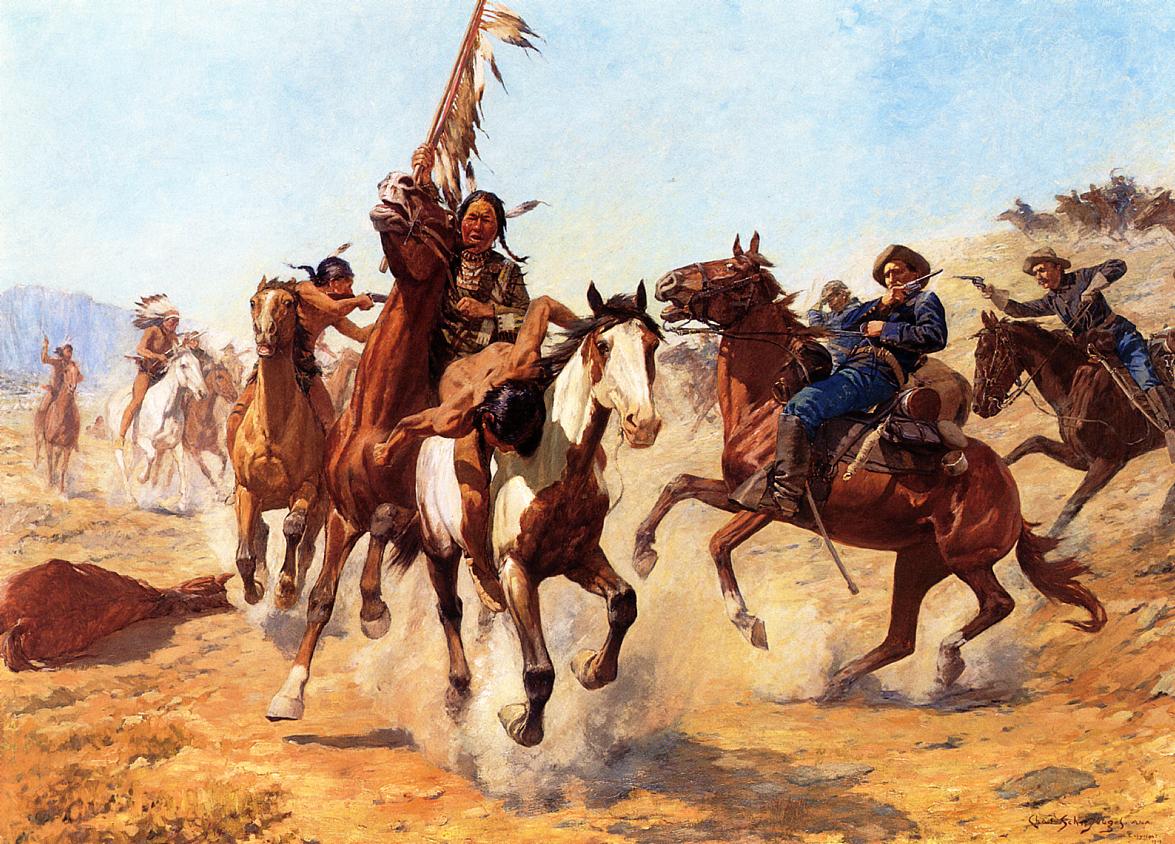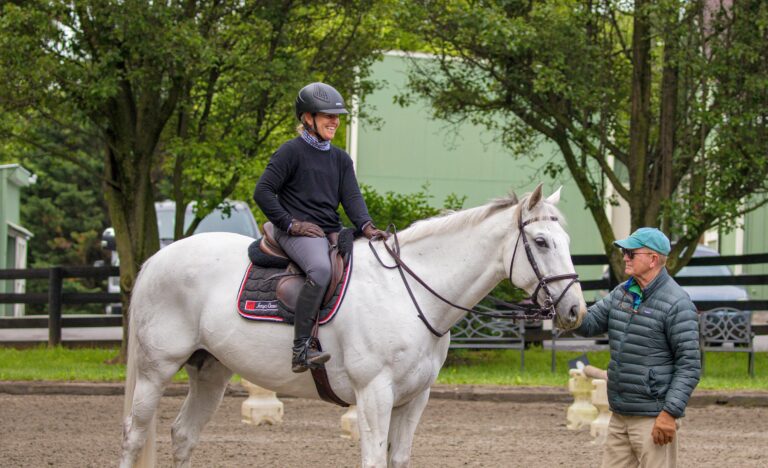
Over the last few columns, I have been looking at mankind’s progress through history, and especially at the hoofprints of the horses that invariably accompanied them.
Let me set the next scene for you: It is November of 1868 and two nations have just signed the Treaty of Fort Phil Kearney, thus ending Red Cloud’s War. In 1868 one party to the treaty, the U.S. Army, is fresh from victory in the most sanguinary conflict the nation has ever endured—the Civil War. This Union army strides across the scene as an all-conquering force, confident of its power, convinced its culture is supreme, and ready to fulfill its manifest destiny. This army is highly mobile, well equipped with new technological inventions and has more than sufficient funds to engage in conflict at any level it chooses.
The opposing force, a mix of Sioux, Cheyenne, Crow and a few other tribes, is also highly mobile, with the herds of horses numbering into the thousands trailing their camps. This force is nomadic, war-like, devoted to its culture and fiercely independent. Despite its numerical, demographic and technological disadvantages, this nation has just defeated the more numerous and more powerful U.S. Cavalry, bringing about the end to Red Cloud’s War.
Red Cloud, the Sioux war chief, had led an unlikely confederation of Native American warriors to inflict painful defeats on the U.S. Cavalry for several years. Although the U.S. Cavalry was fresh from helping to win the Civil War (1861-1865), it was slow to adapt to a struggle with a smaller but more agile adversary. History had lessons to teach the U.S., if only it had taken the time to learn those lessons. Later on, President Harry Truman would remark, “The only thing new in the world is the history you don’t know.” But all that is a story for another time, and other authors.
Westward Ho!
Our story is still one of men and horses and their march through history. Despite provisions that purported to protect Native American lands in the treaty ending Red Cloud’s War, U.S. settlers and pioneers continued their westward expansion. Most of these immigrants had horses, but they used mules and oxen as well to propel their relentless march.
There were several reasons for this expansion—the discovery of gold in the Black Hills and later in California, a belief espoused by many that the U.S. had a “manifest destiny” to hold sway from the Atlantic to the Pacific and the prospect of free land. When President Abraham Lincoln signed the Homestead Act in 1862 (guaranteeing free land to those who would settle on it), he probably signed the death warrant for the Native American way of life.
Most Native American tribes had no concept of ownership of land: An Oglala Sioux named Crazy Horse said, “Treat the Earth well: it was not given to you by your parents, it was loaned to you by your children. We do not inherit the Earth from our Ancestors, we borrow it from our Children.” Red Cloud later bitterly noted that, “They made us many promises, more than I can remember. But they kept but one. They promised to take our land … and they took it.”
Red Cloud had retired after the successful conclusion of his campaigns against the U.S., but his lieutenants carried on the fight. Notable among them was Crazy Horse, who obtained his name after a vision quest. In a trance, he had envisioned himself in a spirit world on a spirit horse that danced and moved in a dream-like fashion.
As with most things in history, opinions are divided about his name, but for our purposes it is notable that Crazy Horse’s name was integral with his love of his horses rather than with his insane courage. By 1866, the year of the Battle-of-the-Hundred-in-Hands (or as the U.S. called it, the Fetterman Massacre), Crazy Horse had become a war leader of the Sioux. He gained this honor in the only way possible for a Native American: personal bravery. At the beginning of that battle he served as a decoy for Red Cloud, riding close to Fetterman’s forces, then taunting and leading them further astray, until it was time to spring the trap. In the years of warfare to come, Crazy Horse would continue to play an important role.

Crazy Horse and Custer
In one of those strange ironies that history produces, as the confrontations between the U.S. and the Native American tribes continued, Crazy Horse was eventually confronted with a mirror image of himself, this time outfitted in Cavalry blue, with his long blond hair hanging down past his collar, and wearing a trademark red scarf: Brigadier General George A. Custer.
By 1876, Custer was the most experienced and successful mounted warrior the U.S. cavalry had to offer. A veteran of 100 mounted skirmishes and battles, Custer—although notable for his personal bravery—was also noted for his arrogance. He was so sure of his command’s ability to defeat any enemy that he left behind the Gatling gun attached to his regiment. One wonders whether, given the rapid-fire capability of the Gatling gun, he could have withstood the attacks of his adversaries if he’d had it with him. Years later, Gen. Douglas MacArthur would remark, “Anyone who believes the pen is mightier than the sword never encountered automatic weapons.” Custer could have benefited from MacArthur’s experience.
Another hard-won military lesson Custer should have applied is that time spent in reconnaissance is never wasted. Had he done a better job of reconnaissance on the morning of June 25, 1876, Custer might have thought twice about attacking the village camped along the banks of the Little Bighorn.
The Sioux and Cheyenne ponies were turned out to graze on the north slopes of the valley, and probably numbered 15,000. This is a large number for animals in one location. (They would have grazed the entire valley bare in a few days.) However, the estimated population of horses in the US at that time was eight million, in a country of about twenty-four million people, meaning on average every third human owned a horse. (These numbers would soon change, as we will shortly discuss.)
The number that Custer should have considered is 2,500, the approximate number of Native American warriors he and his men blundered into that morning. By the next afternoon he and 267 of his command were dead, leaving only the Cavalry mount “Comanche,” who survived the battle. His rider, Capt. Myles Keogh, did not.
Comanche could not talk, but his numerous scars testified to his courage and toughness; in recognition, the 7 Cavalry took care of him for the rest of his life. He was never ridden again, and became somewhat of a pet for the 7 Cavalry troopers. It is fitting that, like many other troopers throughout history, in his later years he developed a taste for beer. I am sure the troopers in charge of his beer rations enjoyed it as much as Comanche.
However, the U.S. cavalryman’s affection for his horse was not unique. Plenty Coups, war chief of the Crow, said, “My horse fights with me and fasts with me because if he is to carry me in battle he must know my heart and I must know his or we shall never become brothers. I have been told that the white man who is almost a god and yet a great fool, does not believe that the horse has a spirit. This cannot be true. I have many times seen my horse’s soul in his eyes.”
On the morning of the Battle of the Little Bighorn, when it became apparent that the Sioux camp was being attacked, a Sioux warrior, Young Hawk, stripped to the waist and prepared for his end. In anticipation of being killed and scalped, he unbraided his hair and tied it with eagle feathers. But first he must say good-bye to his horse. Wrapping his arms around the pony’s neck, he said, “I love you.” Young Hawk survived the Battle of the Little Bighorn; his pony did not.

A New Era Begins
Comanche would not be the last of the U.S. Cavalry horses; that honor would fall to “Chief,” who lived out his years, dying at the ripe old age of 36 in 1968 at Ft. Riley, Kansas near my family’s farm. He lived a pampered life, and I remember seeing him several times before he passed on to “Fiddler’s Green,” the cavalryman’s version of heaven, “where the souls of all dead troopers go.”
Horses continued to leave their footprints on history from the death of Comanche forward, but changes were coming to their world; the development of new technologies was going to exert an ever-increasing effect. More and more machines were produced, thus lessening the need for individual horses, as the power of many horses could be contained within a single machine.
The lessons of technology were already there, for anyone who cared to learn. Up to this date, horses and mankind’s footprints had overlapped— but soon the treads and tires of mechanical vehicles would overrun them. From the date we have just left until the early 1900s, horses continued their role in society as part agricultural worker and part conveyance for soldiers.
As usual, the armies of the world were slow to learn, and horses were still sent into combat where they succumbed to automatic weapons, barbed wire, poison gas, artillery explosions and all the other means that mankind has devised to destroy itself.
The only good—if it can be so described—that came from the charge of the Light Brigade is the immortal poem by Albert, Lord Tennyson. Written about the Battle of Balaclava in 1854, it tells the story of a charge by cavalry against entrenched artillery. Six hundred seventy men and horses started, but 110 men and 375 horses were killed in the valiant but vain attempt. Tennyson wrote the Light Brigade’s epitaph; “Ours not to reason why, ours but to do and die.” And horses, as they had for centuries, willingly galloped with their masters to their fate.
Although technology would replace horses, it would also prove to be a blessing for them. The use of horses for agricultural and transportation purposes continued after World War I (WWI 1914-1918), but even the generals came to agree that horses had little use on the modern battlefield. It is possible that the loss of approximately eight million horses and mules between 1914 and 1918 focused their attention. If not, the additional two and a half million that died in World War II (WWII) between 1939 and 1945 would have helped change their minds.
Good News for Horses: The Forward Seat
We must find silver linings in any cloud that we can, so in a way the period between WWI and WWII is good news for horses and thus for us. An Italian equestrian genius named Federico Caprilli (1868-1907) had developed a system of riding that revolutionized the interaction between horse and rider.
Before Caprilli, the horse conformed to the rider, no matter how awkward or painful the rider’s demands. After Caprilli, the rider conformed to the horse. To this moment, every time a rider softens the reins in the air over a jump, or eases the contact as a horse accepts the pressure of the snaffle, the horse sighs with relief and thanks Caprilli.
Fortunately, Caprilli had his admirers, and the instructional techniques developed during the period between WWI and WWII laid the foundation for the next chapter of the interaction between man and horse. It is hard to over-estimate the impact of Caprilli on what we now call the “horse world.”
In The Undoing Project, Michael Lewis wrote, “A part of good science is to see what everyone else can see but think what no one else has ever said.” In the same vein, we must pause to admire Caprilli and his ability to both feel the natural response of horses and to devise non-confrontational means of riding them.
His insights set the stage for the modern horse world in which the horse is a partner in pleasure rather than a beast of burden. As you can tell, I am a great admirer of Caprilli and will return to him in the future. For now, however, I will close, saying only how fortunate we are to have such a partner, and how we must take care that our footprints and that of our horses continue their path through history.










